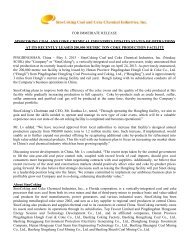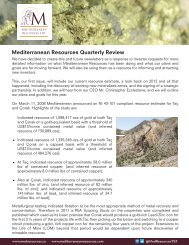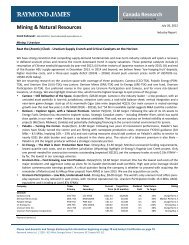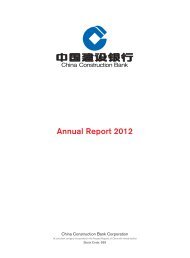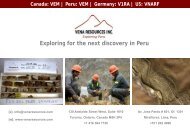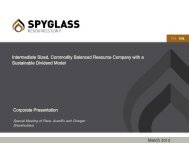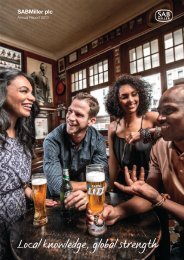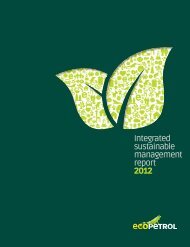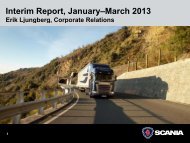Sustainability Report - Primero Mining Corp.
Sustainability Report - Primero Mining Corp.
Sustainability Report - Primero Mining Corp.
- No tags were found...
Create successful ePaper yourself
Turn your PDF publications into a flip-book with our unique Google optimized e-Paper software.
BUILDINGsustainable value1<strong>Primero</strong> sustainability report 2012<strong>Sustainability</strong> <strong>Report</strong> 2012
We at <strong>Primero</strong> are proud to present our second annual<strong>Sustainability</strong> <strong>Report</strong> 1 , which highlights our achievementsand challenges in 2012, our second full yearoperating the San Dimas mine.contentsAbout This <strong>Report</strong> 1Letter from the President and CEO 5Ethical, Transparent Governance 6Building <strong>Primero</strong> Value 9Building our People 12Building our Communities 20Protecting the Environment 26In Closing 33GRI INDEX 34CORPORATE DIRECTORY 372Cover Photo: Jaiden, daughter of Rosenda and Enrique, Miner at San Dimas Mine celebrating Christmas 2012<strong>Primero</strong>1 The 2010sustainability<strong>Sustainability</strong> <strong>Report</strong>reportreported on2012the five months in 2010 that followed <strong>Primero</strong>’s acquisition of the San Dimas property. All currency is in United Statesdollars (USD) unless otherwise noted.
about this reportwe at <strong>Primero</strong> are proud to present oursecond annual <strong>Sustainability</strong> <strong>Report</strong>,which highlights our achievementsand challenges in 2012. This was our second full yearoperating the San Dimas mine in Mexico, since acquiringit in August of 2010 from Goldcorp Inc., a company withestablished and respected sustainability practices.After a record year in 2012, in terms of financial andoperational performance, <strong>Primero</strong> is on track toward ourgoal of building sustainable value: becoming a multi-mine,intermediate precious metals producer, while alwayssupporting sustainable policies and practices in mineexploration, development and operations. <strong>Corp</strong>orateresponsibility is embedded into our daily activities. Ourgoal is to continuously improve workplace health andsafety and environmental performance, while sharing thebenefits of mining with our local communities.A key component of our commitment is transparent,accountable sustainability reporting. Our Board ofDirectors and senior management team are committedto the sustainability reporting process and are workingto improve data collection and encourage employeeengagement in all of our sustainability initiatives.Economic performance is not emphasized in this report:as a public company, our financial results are auditedannually and reported on a regular basis, and our Annual<strong>Report</strong>s, Financial <strong>Report</strong>s and Regulatory Filings areposted on our website.This report covers the period of January 1 throughDecember 31, 2012. Its content is guided by commonprinciples in sustainability reporting in our industry,and the best available data, as reported by the SanDimas mine. In 2013, the Company will begin internalassessments of materiality, and over the medium termwe will broaden these discussions to include variousstakeholder groups. The 2011 <strong>Sustainability</strong> <strong>Report</strong> waspublished in May of 2012, and we will continue to reporton an annual basis.<strong>Primero</strong> sustainability report 2012 1
This report primarily discusses the Company’s operationsat the San Dimas mine in Mexico. The Cerro del Galloproperty is not discussed, as the acquisition of the projectis still in progress. To serve the Company’s growth, theToronto office moved in 2012. The environmental andbroader sustainability impact of this office, along withthose of <strong>Primero</strong>’s Vancouver and Mexico City offices,had little effect on <strong>Primero</strong>’s overall impacts as they arebusiness offices, not mining or exploration properties.As such, the offices’ energy consumption data are notincluded in the environmental data. This report is based ondata collected in 2012, and does not re-state informationprovided in earlier reports. There are no significantchanges from previous reporting periods in the scope,boundary, or measurementmethods applied.For any questions regarding this report or its contentsplease contact us at sustainability@primeromining.com.GRI DECLARATIONThis report is based on the standards of the Global<strong>Report</strong>ing Initiative (GRI), and represents <strong>Primero</strong>’s first<strong>Sustainability</strong> <strong>Report</strong> to attain a GRI G3.1 level C standardof sustainability reporting. The GRI is an independentinstitution that has developed voluntary guidelinesfor sustainability reporting. We believe that the GRIreporting guidelines help us to maintain a high standardof transparency, clarity and comparability, and thatapplying GRI standards demonstrates our commitment totransparent reporting, especially in those categories thatare most important to our stakeholders. A GRI Index canbe found at the back of this report on page 34-35.MANAGEMENT APPROACH TOSUSTAINABILITYAt <strong>Primero</strong>, we believe that sustainability isfundamental to our success. Our prosperity depends2<strong>Primero</strong> sustainability report 2012
on our performance – at the corporate level and in ourrelation to our host communities – in the three pillarsof sustainability: economic achievement, communityengagement and environmental stewardship.ECONOMIC ACHIEVEMENTBy maximizing earnings and reducing operating costs,we produce results for our shareholders while alsocontributing to the economic and social development ofour host communities. Only by creating value and sharingit among shareholders and host communities, can wesustain our company over the long term.COMMUNITY ENGAGEMENTWe actively engage in meaningful dialogue with localresidents, community leaders and organisations toidentify opportunities and priorities for economicimprovement, better training and social development.We support schools, health care and local infrastructure,and we continually seek development opportunitiesthat will contribute to a self-sustaining economy in thecommunities surrounding our operations.OUR STAKEHOLDERSThis report is written for <strong>Primero</strong> stakeholders, including:Employees and their families,Our host communities,Legislators and government officials,Shareholders, investors and financial analysts, Civic, special-interest and non-governmental advocacyorganisations (NGOs).These groups are generally accepted as key stakeholders forsustainability reporting, and we engage with them throughour AGM, community meetings, website and a dedicatedemail address. In the future, as we improve our processes formateriality in sustainability reporting, we will be engaging informal exercises to refine our definition of stakeholders andsurvey their reporting needs.We invite sustainability-related comments andsuggestions at our dedicated email address:sustainability@primeromining.com.ENVIRONMENTAL STEWARDSHIPAt all times, we seek to operate in a responsible mannerand to mitigate the impact our operations may cause tothe environment. We operate with an awareness of themine’s life cycle and practice the progressive rehabilitationof areas affected by our activities.<strong>Primero</strong> sustainability report 2012 3
Our share price at the end of 2012 was 97% higher thanat the end of 2011. Backed by this success, we areentering a phase of expansion in size,diversity and production.4<strong>Primero</strong> sustainability report 2012
Letter from the President and CEOFor <strong>Primero</strong>, 2012 was a record year for revenues,cash flow and reserve growth. This was reflectedin our share price, which finished the year 97%higher than at 2011 year end. Backed by this success, weare entering a phase of expansion in size, asset diversityand production.At the San Dimas mine, newly discovered reserves helpedsupport the mill expansion, which is well underway. Inaddition, we are also headed to becoming a two-minecompany: we have nearly completed the acquisition ofa new, potentially game-changing property, the Cerro delGallo project.Along with this growth comes the obligation tomaintain, and continuously improve, our track record ofsustainability. We believe that we can only thrive when weact with responsibility, transparency and accountabilitytoward our local communities. We share in the benefits ofmining and expend considerable effort in protecting thehealth and welfare of our people, the economies of thecommunities in which they live, and the environment thatsustains us all.Last year I stated two safety objectives: first, to continueour year-on-year decline in accident frequency – whichwe accomplished. The second is still underway: I wantSan Dimas to become a “triple-zero” operation by 2014:zero fatalities, zero lost-time accidents and zero staff onmodified duties. However, despite the emphasis we placeon safe work practices and training, a tragic accidentresulted in a fatality at the San Dimas mine. In response,we commissioned a complete overhaul of our safetyprocedures, followed by a safety retraining program forthe entire workforce.Investors are increasingly concerned with the sustainabilitypractices of mining companies. A lack of dedicatedcommitment to sustainability is seen as a proxy forincreased risk. Throughout the mining industry, climatechange and water availability present significantchallenges. We continually seek new strategies forminimizing our use of water and improving our overallenvironmental performance. Last year, I stated that Iexpected San Dimas to achieve the Mexican government’s“Clean Industry” Certification every year starting in 2012.The certification audit took place this year, and everyone of the auditor’s comments was addressed. Recently<strong>Primero</strong> was granted the “Clean Industry” Certification.I would like to take this opportunity to thank <strong>Primero</strong>’semployees for the hard work and dedication that madethis possible. I’m also proud to recognize our well-trained,professional mine rescue team, who took home firstplace in this year’s Rescue Brigade Competition held inDurango City.Our sustainability policies continue the high standards thatwere originally established by the mine’s previous owner,Goldcorp. These standards have earned us the coveted“ESR” designation (in English, “Socially ResponsibleEnterprise”), for the second consecutive year. As we moveforward, as a two-mine company, we intend to expand oursustainability team, and work toward defining a companywidesustainability framework.In measuring and reporting on our performance, we striveto follow generally accepted international standards - infinancial reporting, health and safety reporting, and in thisreport itself, which is the first <strong>Primero</strong> <strong>Sustainability</strong> <strong>Report</strong>to meet the standards of the GRI 3.1 level C. This was atarget that was established last year, and I am pleasedto say that this report meets those criteria. This report isguided by common principles in sustainability reportingin our industry, and the best available data as reported bythe San Dimas mine. In 2013 we will begin implementinga materiality process with an internal assessment ofmateriality (or determining what is important to ourstakeholders). Over the medium term we will broaden thediscussions to include various external stakeholder groups.This is a long-term goal, aimed at building a culture ofcontinual improvement in sustainability throughout agrowing <strong>Primero</strong>.Joseph F. Conway,President and CEO<strong>Primero</strong> sustainability report 2012 5
Ethical, Transparent Governance<strong>Sustainability</strong> is an integral component of ourcompany-wide strategy. Our establishedsustainability program guides us in policy anddecisions regarding environmental protection, thehealth and safety of our people, and the socio-economicdevelopment of our host communities. We are committedto embedding sustainability in all our daily actions. Ourgoal is to continuously improve workplace health andsafety and environmental performance, and to share thebenefits of mining with local communities.In 2013, as we become a two-mine company, we willbe expanding our sustainability team and program, andworking toward defining a company-wide sustainabilityframework that will guide us in standardizing sustainabilitypractices across all operations.We strive to maintain our well-established safety-focusedculture among our employees, contractors and visitors.This includes continually improving working conditionsand conserving the health and physical safety of all ouremployees. It extends to preserving the environmentand safeguarding the health of the inhabitants of thecommunities in which we operate, who in the future couldbecome our employees.CODE OF BUSINESS CONDUCT AND ETHICSOur operating practices are governed by the principles setout in our Health and Safety Policy and our corporate Codeof Business Conduct and Ethics. The Code is applicableto all directors, officers and employees. It embodies thecommitment of <strong>Primero</strong> and our subsidiaries to conductbusiness in accordance with all applicable laws, rulesand regulations and the highest ethical standards. Thecomplete Code of Business Conduct and Ethics is availablein the <strong>Corp</strong>orate Governance section of the <strong>Primero</strong>website (www.primeromining.com).HEALTH, SAFETY ANDENVIRONMENT COMMITTEE<strong>Sustainability</strong> practices are the responsibility of the Boardof Directors and the Health, Safety and EnvironmentCommittee (HSEC). The purpose of the HSEC is toreview and recommend corporate policies and programsand monitor activities as they relate to health, safety,environment and social matters affecting communitieswhere the Company conducts operations. The HSECreports to the Board. Two out of the three gentlemen onthe HSEC are independent members of our Board, the thirdis Joseph Conway, President and CEO, two HSEC membersare over 50 years of age and two are Canadian nationalswhile the third is a Mexican national.Our internal weekly and quarterly reporting tracks keyHSEC performance indicators, including human resources,health and safety performance, environmental monitoring,compliance with permits, materials inputs and outputs,and community relations activities. The completeHSEC guidelines are available on the <strong>Primero</strong> website(www.primeromining.com).We invite HSEC-related recommendations or directionfrom shareholders, employees or other stakeholders atour dedicated email address:sustainability@primeromining.com. In the future, wehope to develop a process for shareholder resolutions, orother mechanisms, to give minor shareholders a way tooffer their opinions. We also hope to develop a processfor informing and consulting employees about workingrelationships, with formal representation bodies suchas organisation-level ‘work councils’, and employeerepresentation in the HSEC.HUMAN RIGHTS<strong>Primero</strong> respects internationally proclaimed human rights,and strives to ensure that we are not complicit in humanrights abuses.6<strong>Primero</strong> sustainability report 2012
COLLECTIVE BARGAININGAND FREEDOM OF ASSOCIATIONAll <strong>Primero</strong> workers enjoy the right to freedom ofassociation as provided by applicable labour law. TheSan Dimas mine has a trade union, and at the end of2012, approximately 11.5% of San Dimas employees werecovered by a joint committee, and 45.6% of San DimasEmployees were unionized. We do not believe that theright to exercise freedom of association and collectivebargaining is at risk at any <strong>Primero</strong> location.WORKPLACE DIVERSITY,NON-DISCRIMINATION AND EQUITYAt <strong>Primero</strong>, we do not discriminate on the basis of race,religion, ethnicity, national origin, colour, gender, age,sexual orientation, citizenship, veteran status, maritalstatus or disability. Harassment, including sexual, physicaland verbal, is prohibited. We do not allow forced orcompulsory labour.We do not allow child labour, as defined by theInternational Finance <strong>Corp</strong>oration (IFC) as “work bychildren that is economically or likely to be hazardous orto interfere with the child’s education, or to be harmful tothe child’s health or physical, mental, spiritual, moral, orsocial development”. <strong>Primero</strong> will not knowingly employa person who is under the legal age of employment,or where that employment would contravene the IFCdefinition of child labour. There were no incidents of childlabour reported to the Company in 2012, nor were anyoperations considered to have significant risk for incidentsof child labour.COMPLIANCE WITH LAWS AND REGULATIONSIn 2012, there were no legal actions taken against theCompany for anti-competitive behaviour. There was noform of non-monetary sanction taken against the siteduring the reporting period.Two fines were filed against the Company in 2012, bothrelating to a tailings spill that occurred, due to a brokenpipe in the Cupias tailings dam (see the Environment-Tailings section of this report for details). As a result,PROFEPA (the Mexican environmental authority, theProcuraduria Federal de Proteccions al Ambiente)issued recommendations and <strong>Primero</strong> took a number ofcorrective actions. CNA (the water authority, ComisiónNacional del Agua) fined <strong>Primero</strong> $93,500 pesos, whichthe Company promptly paid. PROFEPA also notified theCompany of a $31,200 peso fine, which <strong>Primero</strong> has fileda motion seeking to void. At the time of printing, this issuehad not been resolved.WHISTLEBLOWER POLICYOur corporate Whistleblower Policy allows any employeeto communicate a concern or complaint confidentially andanonymously, with the expectation of a timely responseand the assurance that there will be no retribution ornegative consequences. We provide a confidential emailaddress (reportline@primeromining.com) and a toll-freecomplaint reporting hotline (1-877-508-5716) which isavailable 24 hours a day, 7 days a week.<strong>Primero</strong> sustainability report 2012 7
111,132GOLD EQ OZ PRODUCTION$636CASH COST/GOLD EQ OZ1,980TONNES/DAY THROUGHPUT660,000OUNCES OF GOLD RESERVES8<strong>Primero</strong> sustainability report 2012
Building <strong>Primero</strong> Value<strong>Primero</strong> is a Canadian-based company withheadquarters in Toronto and offices in Vancouverand Mexico City. The company has one operatingmine, the San Dimas Mine, in Mexico’s San Dimas district,and one exploration property, Ventanas, in Durango State,Mexico. Most of the data in this <strong>Sustainability</strong> <strong>Report</strong>relates to our Mexican operations, but our corporateoffices are included where relevant. In December 2012,<strong>Primero</strong> announced an agreement to acquire all issuedand outstanding common shares of Cerro Resources NL.At the time of publication, this deal had not closed andas such, the Cerro del Gallo property is not covered inthis report.TABLE 1. SAN DIMAS FACTSOwnershipLocationDescription100% <strong>Primero</strong>State of Durango (central west Mexico)approximately 150 km west of Durango and 125 km northeast of MazatlánGold-silver depositUnderground mine, using mechanized cut-and-fill mining methods2012 Production Gold equivalent* 111,132 ouncesGoldSilver87,900 ounces5.13 million ounces2012 Staff Employees 1,274Contractors 117% Union members 45.6%% Mexican 100%*Gold equivalent ounces include silver produced and converted to a gold equivalent, based on average commodity prices received in the period.During the reporting period, there were no significant changes in the size, structure, or ownership of the mine.<strong>Primero</strong> sustainability report 2012 9
TABLE 2. DIRECT ECONOMIC REVENUE GENERATED IN 2012Direct economic value generateda) Revenues $182,939,000Economic value distributedb) Operating costs (goods and services) $38,569,645c) Employee wages and benefits $28,683,336d) Payments to providers of capital $19,074e) Payments to governments (Mexico) $591,633f) Community Investments $826,089Economic Value retained $114,249,223Greater detail on the Company’s and mine’s revenues, production, customers and markets is included in the Annual<strong>Report</strong>, which is available on <strong>Primero</strong>’s website: www.primeromining.com.Toronto OfficeDurangoProvinceVancouverOfficeMazatlanDurangoGuanajuatoMexico CityOfficeSan DimasGold-Silver MineVentanasExploration PropertyGuanajuatoProvinceCerro del GalloGold-Silver-CopperDevelopment Project10<strong>Primero</strong> sustainability report 2012
At <strong>Primero</strong>, we believe that sustainability is fundamental toour success. Our prosperity depends on our performance -at the corporate level and in our relation to our hostcommunities - in the three pillars of sustainability: economicachievement, community engagement andenvironmental stewardship.<strong>Primero</strong> sustainability report 2012 11
Building our PeopleOur people are our most valuable asset, and wetreat people fairly and without discrimination,with full regard for their human rights. We knowthat our success depends on the efforts of skilled, hardworkingpeople, and in return we provide ongoing safetyand rescue training, and strive to maintain a safety-awarework culture in which everyone is continually remindedof the importance of keeping themselves and theircolleagues healthy and injury-free.HEALTH AND SAFETYOur commitment to safety, health and welfare includesour employees, contractors and the visitors to our site,and extends to everyone in nearby communities. In2012, tremendous effort was spent on improvements tothe mine’s health and safety management system, andon improving the safety and security behaviour of ourstaff, through education and training, and refinementsto policies and procedures that promote safety.HEALTH AND SAFETY GOVERNANCEAt the San Dimas mine, we operate a number ofcommittees and groups whose purpose is to maintain asafety-first culture and monitor safety performance.Central Safety & Security Committee is a Formal Healthand Safety Committee that guides our Health and SafetyAdministration system. The committee is chaired bythe mine’s General Manager and includes operationsand services superintendents (permanent members)and area heads, supervisors and employees (temporarymembers). The committee meets on a monthly basis todiscuss potential risks and preventive measures, and tochoose a safety “employee of the month”.Documentary System Subcommittee is an 18-membersubcommittee that has joint management/labourrepresentation and defines safety-related workprocedures and instructions.12<strong>Primero</strong> sustainability report 2012
We know that our success depends on the efforts ofskilled, hard-working people, and in return we provideongoing safety and rescue training, and strive to maintain asafety-aware work culture in which everyone is continuallyreminded of the importance of keeping themselves and theircolleagues healthy and injury-free.<strong>Primero</strong> sustainability report 2012 13
Preventive Observations Sub-Committee detectsunsafe acts and conditions and follows up until theyare corrected. In 2012, 4,588 individual “PreventativeObservations” were reported and corrected. There werealso 11 tours of operational areas by multi-functionalgroups. Their submitted observations were followedby 82% verified compliance. This committee is at thefacility level or higher.Prevention Circles have been formed at San Dimasto develop accident prevention solutions related torock fall. These groups help monitor and advise onoccupational safety programs.Accident & Incident Investigation Sub-Committeeanalyzes and investigates events of potential risk. In 2012,thirteen incident and accident investigations took placeand several meetings were held to improve processes andfollow-up on recommendations. Seventy eight percentcompliance with recommendations was observed.COMPLIANCE WITH STANDARDS<strong>Primero</strong> participates in a Self-Management Program onHealth & Safety in the Workplace, in compliance withthe Mexican Secretariat of Labour & Social Welfare(Secretaría del Trabajo y Previsión Social). The results ofthe Secretariat’s evaluation in 2012 were: Health & Safety in the Workplace Management System:97.3% compliantHealth & Safety in the Workplace Standards:95.8% compliantHEALTH AND SAFETY PERFORMANCEThe mining industry recognizes the dangers inherent inthe type of work we do. Accordingly, we place enormousemphasis on safe work practices and training – effortswhich have resulted in a steady year-on-year decline inoverall accident frequency.14<strong>Primero</strong> sustainability report 2012
We seek to be recognized as an employer of choice by offeringcompetitive wages, above-average benefits, as well as bypreferentially hiring locally and recognizing and rewardingemployee performance.However we regret to report a tragic accident that resultedin a fatality at the San Dimas mine in 2012. We respondedby commissioning a complete overhaul of our safetyprocedures, followed by a safety retraining program forthe entire workforce. Our objective is to become a zeroharm operation.TABLE 3. INJURY FREQUENCYInjury Type 2011 2012Lost time injuries 3 6Total reportable injuries 27 20Significant potential incidents 65 42Fatalities 1 1Lost Time Injury Frequency Rate (LTIFR*) 0.18 0.36All Injury Frequency Rate (AIFR**) 1.84 1.5* LTIFR is the number of lost-time injuries per 200,000 hours worked. (Lost-Time Injuries x 200,000 hours) ÷ Total Hours Worked** AIFR is the number of all injuries per 200,000 hours worked.Includes employees and contractors at all sites and corporate offices as well as the corporate exploration team.<strong>Primero</strong> sustainability report 2012 15
This is the seventh year in a row in which theSan Dimas rescue team has won recognition for outstandingperformance in national and regional competitions.EMERGENCY RESPONSEThe San Dimas mine has a history of strong emergencypreparednesspractices, and maintains a specially-trainedrescue team, that is trained and equipped to handle nearlyany type of emergency that could occur in an undergroundmine. Rescue team members receive specialized trainingin first aid, mine rescue and rope rescues includingrappelling and vertical rescue.The San Dimas rescue team won first place in the MineRescue and Bench Test during the Rescue BrigadeCompetition held in Durango City. This is the seventhyear in a row in which our team has won recognitionfor outstanding performance in national and regionalcompetitions.HEALTH PROTECTION AND TRAININGIn addition to injury prevention, the San Dimas mine’sIntegral Safety System is intended to improve thehealth and welfare of our workers, their families and thesurrounding communities. The system seeks to identifyand prevent sickness through ongoing monitoring andcheck-ups, including:Preventive programs for disease detectionEpidemiological disease-detection programs for allemployees exposed to noise, dust, hazardous chemicalsubstances, etcBiological & environmental monitoringAnnual medical examsAnti-doping and alcohol tests for workers16<strong>Primero</strong> sustainability report 2012
San Dimas maintains on-site hospital facilities with x-ray,ultrasound, a surgery room and clinical lab, which areavailable for all employees and contractors. To the bestof the Company’s knowledge, there were no workers whoare involved in occupational activities who have a highincidence or high risk of specific diseases.A monthly safety campaign focuses on a specific topic.The campaigns include awareness talks, training coursesand revision of standards. Topics have included amongothers: lock out – tag out, defensive driving, safety in workat heights and safe handling of sodium cyanide.MANAGEMENT APPROACH TO LABOURPRACTICESThroughout <strong>Primero</strong> we foster a culture of inclusivityand acceptance of gender, race, cultural background,age, religion and disability. We are committed to fair andequitable labour practices in every operation and office.Nearly half (45.6%) of our mining workforce is unionized.In this traditional mining region, and everywhere weoperate, we seek to be recognized as an employer ofchoice by offering competitive wages, above-averagebenefits, as well as by preferentially hiring locally andrecognizing and rewarding employee performance.TABLE 4. STAFF BREAKDOWNLocation Full-Time employees Hourly (Union) Contractors Women Men TotalMexico City Office 10 0 0 4 6 10San Dimas Mine 576 581 117 115 1,159 1,274Vancouver Office 3 0 3 4 2 6Toronto Office 13 0 0 5 8 13Total 602 581 120 128 1,175 1,303TABLE 5. LOCAL SENIOR MANAGEMENT*Number of Senior Managers 17%Percent who are local residents(Naturalised citizens orpermanent visa holders)99%REGIONAL HIRING1% Otros state8% Guanajuato state6% Zacatecas state9% Sinaloa state* Senior management is defined as Superintendents, Managers, andGeneral Manager.76% Durango state<strong>Primero</strong> sustainability report 2012 17
HEALTH AND SAFETY AGREEMENTSMany employment positions at the San Dimas mine areunionized, which includes health and safety agreements.The following health and safety topics are covered by localagreements signed by <strong>Primero</strong>:Personal protective equipmentJoint management-employee health and safetycommitteesParticipation of worker representatives in health andsafety inspections, audits, and accident investigationsDISTRIBUTION OF EMPLOYEE TRAINING95%OF ALL 1,216WORKERSRECEIVEDTRAININGASSISTANTS 2%SUPERINTENDENTS 1%AREA HEADS 5%LABOURERS 38%SUPERVISORS 54%Training and educationRight to refuse unsafe workPeriodic inspectionsTABLE 6. EMPLOYEES COVERED BY JOINTHEALTH AND SAFETY COMMITTEESNumber of employees 1,274Employees covered by joint agreements 147 (11.5%)WORKER AND MANAGEMENT TRAINING<strong>Primero</strong> runs an annual training program forsuperintendents, area managers, supervisors and workers.The training is developed based on the needs of eachdepartment and depending on the area, training can betaken in person or online. Topics include:Workshops in electrical maintenance, mechanical andhydraulic equipment for mineWorkshops in handling explosives and hazardoussubstancesHuman development workshopsManagement workshopsLeadership workshopsMine rescue crew workshops“Tools for the job” workshops<strong>Primero</strong> carries out an annual performance evaluationfor every employee, which covers personal developmentobjectives, skills and abilities. The company has standardpolicies for providing benefits to employees who studyor teach. For unionized workers, a worker-preparationscholarship is provided in one of the clauses of theunion’s agreement.COMMUNITY TRAININGThe College of Professional Technical Education(CONALEP) trade school in Tayoltita was established in2004 by the San Dimas mine in cooperation with the stategovernment. The San Dimas mine funded the constructionand equipping of the school and provided 50% of teachers’salaries for the first five years of operation. Its purpose is toimprove the career prospects for local youth, and provide asource of trained young professionals for the mine.CONALEP’s first class of 37 students graduated theMetallurgy and Electromechanical programs in 2007. Todate, approximately 130 students have graduated, 60% ofwhom have joined the <strong>Primero</strong> workforce.In terms of assistance programs to support employeeswho are retiring or who have been terminated, <strong>Primero</strong>provides severance pay.18<strong>Primero</strong> sustainability report 2012
CONALEP’s first class of 36 students graduated theMetallurgy and Electromechanical programs in 2007. Todate, approximately 130 students have graduated, 60% ofwhom have joined the <strong>Primero</strong> workforce.<strong>Primero</strong> sustainability report 2012 19
Building our CommunitiesWe at <strong>Primero</strong> are constantly aware thatevery action we take has an effect onnearby communities. We are gratefulthat we are welcome among them and feel theobligation to improve conditions for local communitieswhere possible.COMMUNITY DEVELOPMENTWe are committed to maintaining a vibrant,economically diverse local community. The San Dimasmine has brought significant infrastructure upgradesto the community, in the form of improvementsto roads, electrical and communication systemsand medical facilities. Although these weredeveloped to serve the mining operations, theyare shared by the entire community. In addition tothese benefits, we actively contribute to a broadrange of social and community initiatives, often incollaboration with local and regional authorities.In the larger community, we are helping to create asustainable local economy through small businessdevelopment, and have helped launch many new smallbusinesses including a greenhouse garden, bakery,laundromat, chicken farm and sewing centre. We havecontributed to the construction of sports facilities forthe community’s benefit. We support local health carefacilities and subsidize childcare, to help our workingparentemployees and the communities at large. Wepromote the growth of a self-sustaining local economyby helping to develop new, non-mining businesses.TABLE 7. PUBLIC INFRASTRUCTURE/COMMUNITY CONTRIBUTIONS*Community infrastructure facilities(water supply, roads, schools,hospitals, etc.)Community services(through funding of costs and/orstaffing with <strong>Primero</strong> employees)$232,734$593,355*Donations for infrastructure and provision of services, provided primarily as apublic service, from which <strong>Primero</strong> does not seek to gain direct economic benefit20<strong>Primero</strong> sustainability report 2012
Our subsidy benefits a total of 255 students, including 70preschool students, 120 elementary and 65secondary students.<strong>Primero</strong> sustainability report 2012 21
COMMUNITY TRAININGWe support education and training, though subsidizingteachers’ salaries, building classrooms and helping topay the tuition for hundreds of students from pre-schoolthrough secondary school. We subsidize technicalcolleges and technical training for future miners.In collaboration with the Mexican government, wesupport an Adult Education Program that is available toemployees, their families and other local residents.In addition to our funding of the CONALEP trade school inTayoltita, <strong>Primero</strong> provides a 75% subsidy to the studentsattending the Patronato Pro Escuela Bruno Martínezschool in Tayoltita, whether or not they are children ofmine workers. Our subsidy benefits a total of 255 students,including 70 preschool students, 120 elementary and 65secondary students.TABLE 8. ACADEMIC SCHOLARSHIPSNumber of scholarships Level of study Staff that benefits21 Technical High School Studies Union workers’ children12 Computing courses Union workers’ children7 Technical studies / CONALEP Union workers’ children8 High School Employees’ children10 Bachelor’s degree Employees’ children2 Master’s degree Employees’ children22<strong>Primero</strong> sustainability report 2012
In response to employee requests for greater careeropportunities and skills development, we teamed upwith the Mexican government and launched an AdultEducation Program for employees, families and residents.Since 2006, more than 260 students have graduated fromthe program.<strong>Primero</strong> and the Public Security Secretariat provided aSchool for Parents workshop on teen education. This sixmonthprogram (three sessions per month) was attendedby a pilot group of 60 workers.Over 1,300 students attended workshops andpresentations on addiction and addiction prevention. Over150 hours of prevention activities were delivered, directedat primary, secondary and high school levels.TRAINING WOMENWe promote the economic status of women by proactivelyhiring female workers in all areas, and we support thetraining of women for heavy-duty equipment operations.The “Miner Women” project aims to increase the numberof women employed in all areas of the San Dimasoperation, and to elevate their status and improve theirquality of life. Women have been recruited and trained asspecialized machinery operators, especially large, heavydutyequipment and electro-hydraulic jumbos. Graduatesof the program become significant financial contributors,and in some cases, the family’s sole income earner.For the third year in a row, we collaborated withSEMARNAT (the Mexican Secretariat of Environmentand Natural Resources) to deliver a workshop on “Productmanufacturing using solid wastes”. Forty women (wivesof mine workers) from the Las Truchas communityparticipated, and benefited from a three-week temporaryemployment program.CHILD CAREWith the change of administration of the FederalGovernment, the daycare facilities program that operatedin Tayoltita through the Secretariat of Social Development(SEDESOL) was closed. One of the factors in this decisionwas the low attendance in recent months by children ofthe community. The facilities were returned to <strong>Primero</strong>.SEDESOL is willing to support the reinstatement of thedaycare program should the Company and communityrequest it.ENVIRONMENTAL AWARENESSIn 2012, <strong>Primero</strong> delivered 122 environmental-educationtalks in primary, elementary and secondary schools,reaching a total of 2,639 students. Another 56 talks weregiven to company workers.<strong>Primero</strong> sustainability report 2012 23
Subjects covered included: Piaxtla River Water Quality;the Tailings Filtering Process; the Piaxtla River CleaningCampaign; Hazardous Waste Management, Saving Energy,Saving Water and Global Warming.CULTURE AND RECREATIONRecreational, cultural and sporting activities were providedfor employees and their families in the mining camp.Sports activities ranged from weightlifting, aerobic trainingand taekwondo to tennis and swimming. Cultural andrecreational activities included painting, tailoring, andhair-cutting workshops.COMMUNITY SURVEYIn 2011, we conducted a community needs assessmentsurvey, intended to determine the economic, social andcultural situation and needs of the San Dimas community.925 surveys were completed, representing 95% of thelocal community. The results formed the basis of our 2011 -2015 community plan and annual surveys will be repeateduntil 2015, in order to evaluate the results of the programsthat we implement.After 2015, we will continue the annual survey to gatherinformation on general family relationships, health,community and addiction.PRIMERO MAGAZINEIn 2012 we launched <strong>Primero</strong> Magazine, a bimonthlymagazine that serves as a communication channel to theworkers of San Dimas and their community. It promotesachievements and supports the community’s personal andsocio-cultural growth. The six issues that were produced in2012 were very well received by readers.MINER’S DAY OPEN HOUSEOn July 11, Miner’s Day, the Company’s facilities weredevoted to a mini-exposition, in which the communityand workers’ families were invited on a tour to view themachinery and equipment. The tour allowed children tosee their parents’ workplace.24<strong>Primero</strong> sustainability report 2012
The “Miner Women” project aims to increase the numberof women employed in all areas of the San Dimas operation,and to elevate their status and improve their quality of life.ESR RECOGNITIONIn April 2013, we were once again designated a “SociallyResponsible Enterprise” (ESR) by the Mexican Centre forPhilanthropy (Centro Mexicano para la Filantropia). Wealso received ESR designation in 2012.The ESR designation has been earned by fewer than774 companies across Mexico. It recognizes companiesoperating in Mexican territory that make a voluntaryand public commitment to manage their activitiesin a socially responsible way, as part of their cultureand business strategy. It indicates that a company iscommitted to sustainability in four key areas:1. Business ethics2. Care and preservation of the environment3. Quality of life in the Company4. Bonds with the community<strong>Primero</strong> sustainability report 2012 25
Protecting the EnvironmentOur environmental focus is to act withresponsibility and transparency in developingmining projects and to proactively seek tominimize the footprint of our operations. Precautionarymeasures are taken to avoid damage to ecosystemswherever possible. When adverse impacts occur,integrated programs are implemented to promote therecovery of the affected ecosystems.MANAGEMENT APPROACH TOENVIRONMENTAL RESPONSIBILITYOur mining, exploration and development activitiesare subject to the applicable environmental laws andregulations, which include planning for the eventualclosure of the mine and reclaiming the miningproperties after mining and processing has ceased.At all times, we manage the San Dimas minein compliance with, or in excess of, all relevantenvironmental standards. The EnvironmentalManagement System (EMS) in place at San Dimashelps reduce or eliminate environmental impactsthrough precautionary measures that mitigate damageand promote recovery and reclamation. Our system iswidely respected for its effectiveness in identifying andavoiding, reducing or eliminating the environmentalimpacts of mining and processing. Our aim at SanDimas is to match the environmental standards of theleading gold and silver producers.Recently, <strong>Primero</strong> was granted the “Clean Industry”Certification by the Procuraduria Federal de Proteccional Ambiente (Mexican EPA).ENERGY CONSUMPTION AND GREENHOUSEGAS EMISSIONSIn the past, all of the energy consumed in the Districtof San Dimas was provided by the Federal Commissionof Electricity (Comisión Federal de Electricidad yGeneradores) with the exception of back-up diesel26<strong>Primero</strong> sustainability report 2012
Our Environmental Management System (EMS)is widely respected for its effectiveness in identifyingand avoiding, reducing or eliminating the environmentalimpacts of mining and processing.<strong>Primero</strong> sustainability report 2012 27
generators. In 2008, the Las Truchas hydroelectricplant began operation. Today, our San Dimas mineenergy use and GHG emissions are significantlydecreased by our use of hydroelectric power from theLas Truchas hydroelectric plant, which is owned andoperated by <strong>Primero</strong>.The Las Truchas dam and power plant harness thepower potential of the Las Truchas basin to provide themine with economical, reliable and clean power. The 34kVA power line runs 42 km from the dam to the SanDimas mine. In 2010 a Phase I expansion wasconnected to the Federal Commission of Electricity’ssupply system.In 2012, a Phase II expansion was approved, that willincrease capacity from its current 50 MW/h toapproximately 70 MW/h. This would support mineexpansion and allow excess power to be sold into theMexican national energy grid.<strong>Primero</strong> uses both direct (e.g. primary energy sourcessuch as diesel and gasoline) and indirect (energy thatis produced by converting primary energy into otherforms (e.g. electricity)) energy. The tables belowoutline the different sources that are used atSan Dimas.TABLE 9. ENERGY CONSUMPTIONDirect 2011 2012Diesel (stationary) 17,940.96 GJ 22,382.73 GJDiesel (transport) 90,592.52 GJ 89,134.29 GJGasoline (000s litres) 3,764.45 GJ 2,047.33 GJIndirectElectricity purchased5,029.20 GJ(diesel generators)142,365.60 GJ(las Truchas)66,438.00 GJ(Mexican FederalPower Commission)12,517.20 GJ(diesel generators)123,847.20 GJ(las Truchas)98,481.60 GJ(Mexican FederalPower CommissionElectricity generated on site 17,940.96 GJ 22,382.73 GJIncreased production in 2012 is largely responsible for the higher energy use and Greenhouse Gas emissions.28<strong>Primero</strong> sustainability report 2012
The drought of 2011 led to the use of diesel generatorsin 2012 due to the short supply of water that affectedoperations of the Las Truchas hydroelectric dam. Todetermine greenhouse gas emissions at San Dimas,energy consumption information for the different areasof the mine is taken from an internal register. Thesenumbers are subsequently multiplied by the NationalGreenhouse Accounts Factors to convert fuel amountsinto atmospheric emissions (in CO 2e). These CO 2conversion factors are the same factors that were usedwhen the mine was owned by Goldcorp.TABLE 10. GREENHOUSE GAS EMISSIONS (AS TONNES OF CO 2e)Direct 2011 2012Diesel (stationary) 1,323 1,651.60Diesel (transport) 6,823 6,714.20Gasoline 272 146.80IndirectElectricity 8,396 15,236.50Total 16,516 23,749.10CLEAN INDUSTRY CERTIFICATIONFor years, San Dimas has been “Clean Industry”certified by PROFEPA. In 2012 the Clean Industrycertification audit was completed and we passed with100%. The report was submitted to PROFEPA andcertification was granted in early 2013.The San Dimas operation has also been engaged in avoluntary self-evaluation program for many years, withthe aim of improving performance by identifyingdeficiencies, measuring performance and implementingimprovement programs to remain in compliance with allof the relevant regulations. As Mexican laws andregulations evolve and become more closely alignedwith world standards, we at <strong>Primero</strong> are committed toremaining in compliance.The study confirmed that:Particulates from mining processes were in compliancewith regulations (NOM-043-SEMARNAT-1993)Emissions from the plant’s burners were in compliancewith regulations (NOM-085 - SEMARNAT-1994, forburners with heating capacity of less than 5250 Mj/h).WATERWater management is a prime concern at <strong>Primero</strong>.Rainwater is scarce in the San Dimas region and ourobjective at all times is to minimize water use throughrecycling, re-use and treatment. In 2012, 501,300 m 3 ofwater were recycled (e.g. returned from the tailingsdam), up from 281,000 m 3 in 2011.AIR QUALITY MEASUREMENTIn 2012, we engaged a third-party contractor (On-SiteAnalítica de México, S. A de C.V.) to carry out anatmospheric study of the San Dimas operation.<strong>Primero</strong> sustainability report 2012 29
TABLE 11. WATER USEWater Source 2012Self-extracted water (water drawn from the environment viaa facility or equipment controlled by the operation (e.g. bores,rivers, dams. etc.)Surface water, (including water from wetlands, rivers,lakes, and oceans)328,000 m 3Ground water 316,000 m 3Rainwater collected directly and stored by thereporting organisation;012,000 m 3Waste water from another organisation 0Municipal water supplier or other water utilities(drawn directly from a public facility)Total water used 610,000 m 30WASTE MANAGEMENTAt San Dimas, waste materials are generated. Nonhazardousprocess waste includes the rock andmaterials that are removed in order to access themineralized ore, and the tailings and waste rock thatare left after the valuable gold and silver mineralconcentrate has been extracted. Hazardous wastes arematerials that can pose a threat to health unless safelymanaged (e.g. used oil or grease, contaminated soil,batteries, etc).TABLE 12. HAZARDOUS AND NON-HAZARDOUS WASTEWaste Type 2012Non-hazardous waste268 tonnesHazardous wastes131 tonnesIn 2012, we submitted two waste management plansto SEMARNAT:The Hazardous Waste Management Plan wasdeveloped with the aim of planning, reducing,collecting, storing, transporting, and performing finaldisposal of hazardous residues generated by service,exploration, mining, and extraction of gold and silverminerals from the mine site.The <strong>Mining</strong> Waste Management Plan implementsa comprehensive management system for miningwaste materials, such as waste rock and tailings, andimplementing operational techniques for reusing and30<strong>Primero</strong> sustainability report 2012
Following a number of improvements relating to the stabilityof the dams and the management of our tailings, our tailingssites fully comply with international guidelines.reducing them. It also ensures that areas destinedfor final disposal comply with safety measures toensure the stability of the deposit, preventing thedispersion of acid drainage, leachate and runoffs tothe environment – including monitoring.In 2012 we also submitted a plan for Special Wastemanagement (electronics, scrap metals and tires) tothe State of Durango’s Ministry of Natural Resources.This plan should significantly reduce the generation ofspecial waste and ensure appropriate disposal, thuspreventing environmental damage.TAILINGSTailings management at San Dimas is challenged by thedistrict’s rugged terrain and steep canyons. Followinga number of improvements relating to the stability ofthe dams and the management of our tailings over anumber of years, our tailings sites fully comply withinternational guidelines.At the Tayoltita tailings operation, significant capitalimprovements have been made in recent years.Pumps and pumping systems have been upgraded.Spill containment systems have been improved and aspill recovery trough installed. The tailings dam areawas fenced to prevent access by people and animalsand further improvements to the dam and operatingpractices are planned.In the Piaxtla River, downstream of the Tayoltita tailingsdeposits, water quality monitoring has not shown anyenvironmental impact, although in periods of heavyrain, the suspended solids in the water increase anaverage of 43,000 tonnes of solution per month, whichwas recycled into the leaching process.In January 2012, a tailings spill occurred, due toa broken pipe in the Cupias tailings dam. Tailingscontaining 5 ppm cyanide were spilled into the PiaxtlaRiver, affecting a total area of 2.5 kilometres. The fault<strong>Primero</strong> sustainability report 2012 31
was corrected and the relevant water management andenvironmental authorities, CNA and PROFEPA, werenotified. The municipality of San Dimas consideredthe incident to be localized and under control andstated that the efficiency of <strong>Primero</strong>’s emergencyresponse limited the damages to the death of smallconcentrations of fish, without any impact onother animals.PROFEPA issued recommendations, and all theirrequests were implemented. <strong>Primero</strong>’s correctiveactions included the design and construction of acontainment structure for the tailings pipe, which willbe fully operational by June 2013 once installation of asecond new tailing pump is complete.In September, CNA fined <strong>Primero</strong> $93,500 pesos,which the Company promptly paid. Following the finalCNA resolution, PROFEPA notified the Company of a$31,200 peso fine for non-compliance to a “hazardouswaste” regulation. <strong>Primero</strong> filed a motion with theH. Tribunal De Justicia Fiscal and Administrativa inNovember to void PROFEPA’s resolution. At the time ofprinting, this issue had not been resolved.TABLE 13. MINING WASTEProcess Waste 2011 2012Waste Rock(000s tonnes)1,03876% within the mine,24% outside the mine950Biodiversity and Aquatic MonitoringIn 2012 we continued to engage a third-party consultant(Environmental Consulting and Technology Inc. de CV) tomonitor water quality and the abundance and diversity ofaquatic life in the Piaxtla River, at five monitoring stationsupstream and downstream from the San Dimas mine.At all monitoring stations, the aquatic habitat was suboptimal,but its characteristics were suitable to supportthe epifauna and fish populations.Through these studies of aquatic life, the consultants haveidentified and reported fish species that were not thoughtto be in the Piaxtla River, and <strong>Primero</strong> has providedscientific data to the CONABIO database, of the NationalCommission for the Knowledge and Use of Biodiversity.Mine Closure and ReclamationEvery mine has a finite life and as mining progressesat San Dimas, we continue to update our plans for themine’s eventual closure. In our financial statements wehave accounted for the reclamation and closure costs forthe mine, which ensure that the lands and water will bereturned to a safe and environmentally sound state ontermination of mining.While operations continue, we practice progressivereclamation of any lands that are no longer used formining activities. In 2011 we reclaimed three of the oldertailings dams near the Tayoltita mill, and used the landas a soccer field, a softball field, and a garden nursery. In2012, reclamation was completed on the tailings facilitiesof the San Antonio Mill, which was closed in 2003.Tailings(000s tonnes)663 80032<strong>Primero</strong> sustainability report 2012
in closingIn this, our second annual <strong>Sustainability</strong> <strong>Report</strong>, we at <strong>Primero</strong> are demonstrating ourcommitment to improving the quality and thoroughness of our reporting standards andpractices. These efforts have resulted in the first <strong>Primero</strong> <strong>Sustainability</strong> <strong>Report</strong> to meetthe Global <strong>Report</strong>ing Initiative 3.1 Guidelines, Level C.As we move forward, we hope to build a culture of continual improvement in sustainabilitythroughout a growing <strong>Primero</strong>. In this report we have set numerous performance targetsfor 2013 and beyond, based on an ongoing initiative for improvement in the scope,depth and transparency of our reporting, to meet the increasing expectations of allof our stakeholders.<strong>Primero</strong> sustainability report 2012 33
gri indexPROFILE DISCLOSURES1. STRATEGY AND ANALYSIS Source page1.1 Statement from the most senior decision-maker of the organization 52. ORGANIZATIONAL PROFILE2.1 Name of the organization Cover2.2 Primary brands, products, and/or services 9, 102.3Operational structure of the organization, including main divisions, operatingcompanies, subsidiaries, and joint ventures92.4 Location of organization's headquarters 92.5Number of countries where the organization operates and names of countries witheither major operations or that are specifically relevant to the sustainability issuescovered in the report92.6 Nature of ownership and legal form 1, 92.7Markets served (including geographic breakdown, sectors served, and types ofcustomers/beneficiaries)102.8 Scale of the reporting organization 9, 102.9 Significant changes during the reporting period regarding size, structure, or ownership 2, 92.10 Awards received in the reporting period 5, 16, 253. REPORT PARAMETERS3.1 <strong>Report</strong>ing period (e.g., fiscal/calendar year) for information provided 13.2 Date of most recent previous report (if any) 13.3 <strong>Report</strong>ing cycle (annual, biennial, etc) 13.4 Contact point for questions regarding the report or its contents 2, 373.5 Process for defining report content 13.6Boundary of the report (e.g., countries, divisions, subsidiaries, leased facilities, jointventures, suppliers)23.7 State any specific limitations on the scope or boundary of the report 23.83.103.11Basis for reporting on joint ventures, subsidiaries, leased facilities, outsourcedoperations, and other entities that can significantly affect comparability fromperiod to period and/or between organizationsExplanation of the effect of any re-statements of information provided in earlierreports, and the reasons for such re-statement (e.g. mergers/acquisitions, changeof base years/periods, nature of business, measurement methods)Significant changes from previous reporting periods in the scope, boundary, ormeasurement methods applied in the reportN/A223.12 Table identifying the location of the Standard Disclosures in the report 234<strong>Primero</strong> sustainability report 2012
4. GOVERNANCE, COMMITMENTS, AND ENGAGEMENT Source page4.14.24.34.4Governance structure of the organization, including committees under the highestgovernance body responsible for specific tasks, such as setting strategy ororganizational oversightIndicate whether the Chair of the highest governance body is also anexecutive officerFor organizations that have a unitary board structure, state the numberof members of the highest governance body that are independent and/ornon-executive membersMechanisms for shareholders and employees to provide recommendations ordirection to the highest governance body6, 376, 376, 3764.14 List of stakeholder groups engaged by the organization 34.15 Basis for identification and selection of stakeholders with whom to engage 3PERFORMANCE INDICATORSECONOMICEC1EC7EC8Direct economic value generated and distributed, including revenues, operatingcosts, employee compensation, donations and other community investments,retained earnings, and payments to capital providers and governmentsProcedures for local hiring and proportion of senior management hired from thelocal community at significant locations of operationsDevelopment and impact of infrastructure investments and services providedprimarily for public benefit through commercial, in-kind, or pro bono engagementENVIRONMENTAL101720, 24EN3 Direct energy consumption by primary energy source 28EN4 Indirect energy consumption by primary energy source 28EN8 Total water withdrawal by source 30EN16 Total direct and indirect greenhouse gas emissions by weight 29SOCIALLA1 Total workforce by employment type, employment contract, and region 17LA6Percentage of total workforce represented in formal joint management workerhealth and safety committees that help monitor and advise on occupational healthand safety programs12, 14, 18LA9 Health and safety topics covered in formal agreements with trade unions 18LA11HR5HR6SO7SO8Programs for skills management and lifelong learning that support the continuedemployability of employees and assist them in managing career endingsOperations identified in which the right to exercise freedom of associationand collective bargaining may be at significant risk, and actions taken to supportthese rightsOperations and significant suppliers identified as having significant risk forincidents of child labor, and measures taken to contribute to the effective abolitionof child laborTotal number of legal actions for anti-competitive behavior, anti-trust, andmonopoly practices and their outcomesMonetary value of significant fines and total number of non-monetary sanctions fornon-compliance with laws and regulations187777, 32<strong>Primero</strong> sustainability report 2012 35
CAUTIONARY STATEMENTThis report may contain “forward-looking” statements within the meaning of Canadian securities legislation and the UnitedStates Private Securities Litigation Reform Act of 1995. Forward-looking statements relate to future events or the anticipatedperformance of the Company and reflect management’s expectations or beliefs regarding such future events and anticipatedperformance. In certain cases, forward-looking statements can be identified by the use of words such as “plans”, “expects”,“is expected”, “budget”, “scheduled”, ”estimates”, ”forecasts”, ”intends”, ”anticipates” or “believes”, or variations of suchwords and phrases or statements that certain actions, events or results “may”, ”could”, “would”, ”might”, or “will be taken”,“occur” or “be achieved”, or the negative of these words or comparable terminology. By their very nature forward-lookingstatements involve known and unknown risks, uncertainties and other factors which may cause the actual performance of theCompany to be materially different from any anticipated performance expressed or implied by the forward-looking statements.Such factors include various risks related to the Company’s operations, including, without limitation, fluctuations in spot andforward markets for gold, silver and other metals, fluctuations in currency markets, changes in national and local governmentsin Mexico and the speculative nature of mineral exploration and development, risks associated with obtaining necessaryexploitation and environmental licenses and permits, and the presence of laws that may impose restrictions on mining.A complete list of risk factors are described in the Company’s annual information form and will be detailed from time totime in the Company’s continuous disclosure, all of which are, or will be available, for review on SEDAR at www.sedar.com.36<strong>Primero</strong> sustainability report 2012
corporate directoryDIRECTORSWade NesmithChairmanVancouver, British ColumbiaJoseph F. Conway 1President & Chief Executive Officer,<strong>Primero</strong> <strong>Mining</strong> <strong>Corp</strong>.Toronto, Ontario2, 3, 4, 5David DemersChief Executive Officer,Westport Innovations Inc.Vancouver, British ColumbiaGrant Edey 3, 5President & Chief Executive Officer,Khan Resources Inc.Mississauga, OntarioRohan Hazelton 1, 5Vice President Strategy, Goldcorp IncVancouver, British ColumbiaTimo Jauristo 2Executive Vice President<strong>Corp</strong>orate Development,Goldcorp Inc.Vancouver, British ColumbiaEduardo Luna 1<strong>Corp</strong>orate DirectorMexico City, MexicoRobert A. Quartermain 2, 3President & Chief Executive Officer,Pretivm Resources Inc.Vancouver, British ColumbiaMichael Riley 5<strong>Corp</strong>orate DirectorVancouver, British ColumbiaBOARD COMMITTEES1 Member of the Health, Safety andEnvironment Committee2 Member of the Human Resources andCompensation Committee3 Member of the Governance andNominating Committee4 Lead Director5 Member of the Audit CommitteeOFFICERSJoseph F. ConwayPresident & Chief Executive OfficerRenaud AdamsChief Operating OfficerDavid BlaiklockChief Financial OfficerTamara BrownVice President, Investor RelationsH. Maura LendonVice President, Chief GeneralCounsel & <strong>Corp</strong>orate SecretaryDavid SandisonVice President, <strong>Corp</strong>orate DevelopmentGabriel VoicuVice President, Geology & ExplorationCORPORATE OFFICESVancouverOne Bentall CentreSuite 1640505 Burrard Street, Box 24Vancouver, BC V7X 1M6CanadaT: 604 669 0040F: 604 669 0014TF: 1 877 619 3160TorontoSuite 2301, 20 Queen Street WestToronto, ON M5H 3R3CanadaT: 416 814 3160F: 416 814 3170TF: 1 877 619 3160<strong>Primero</strong> <strong>Mining</strong> is a proud memberof the World Gold Council.Production NotesDesign and Production Macrae DesignLocation PhotographySalvador Casares Bonastre/Diseña - Creatividad a... Tiempo!Printed in CanadaOPERATION OFFICESMexico CityArquimedes 33, 2nd FloorColonia Polanco11560 Mexico, D. F.MexicoT: +52 55 52 80 6083INQUIRIESTamara BrownVice President, Investor RelationsT: 416 814 3168E: info@primeromining.comTania ShawManager, Investor RelationsT: 416 814 3179E: info@primeromining.comWEBSITEwww.primeromining.comWe welcome feedback on thisreport or on any other aspectof sustainability at <strong>Primero</strong>.Please contact us atsustainability@primeromining.com.This paper has been certified to meetthe environmental and social standardsof the Forest Stewardship Council ®(FSC ® ) and comes from responsiblymanaged forests and/or verifiedrecycled sources.



